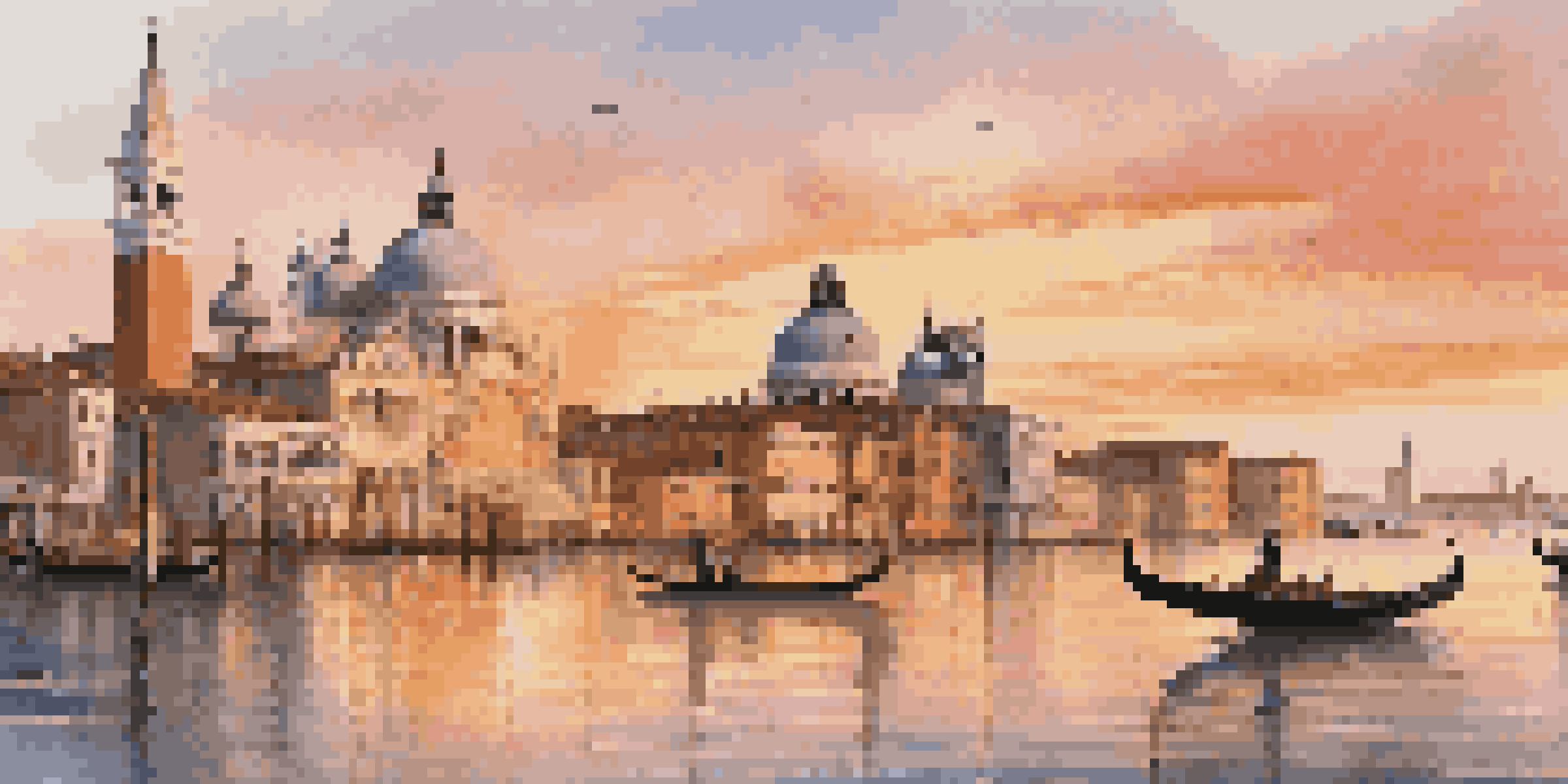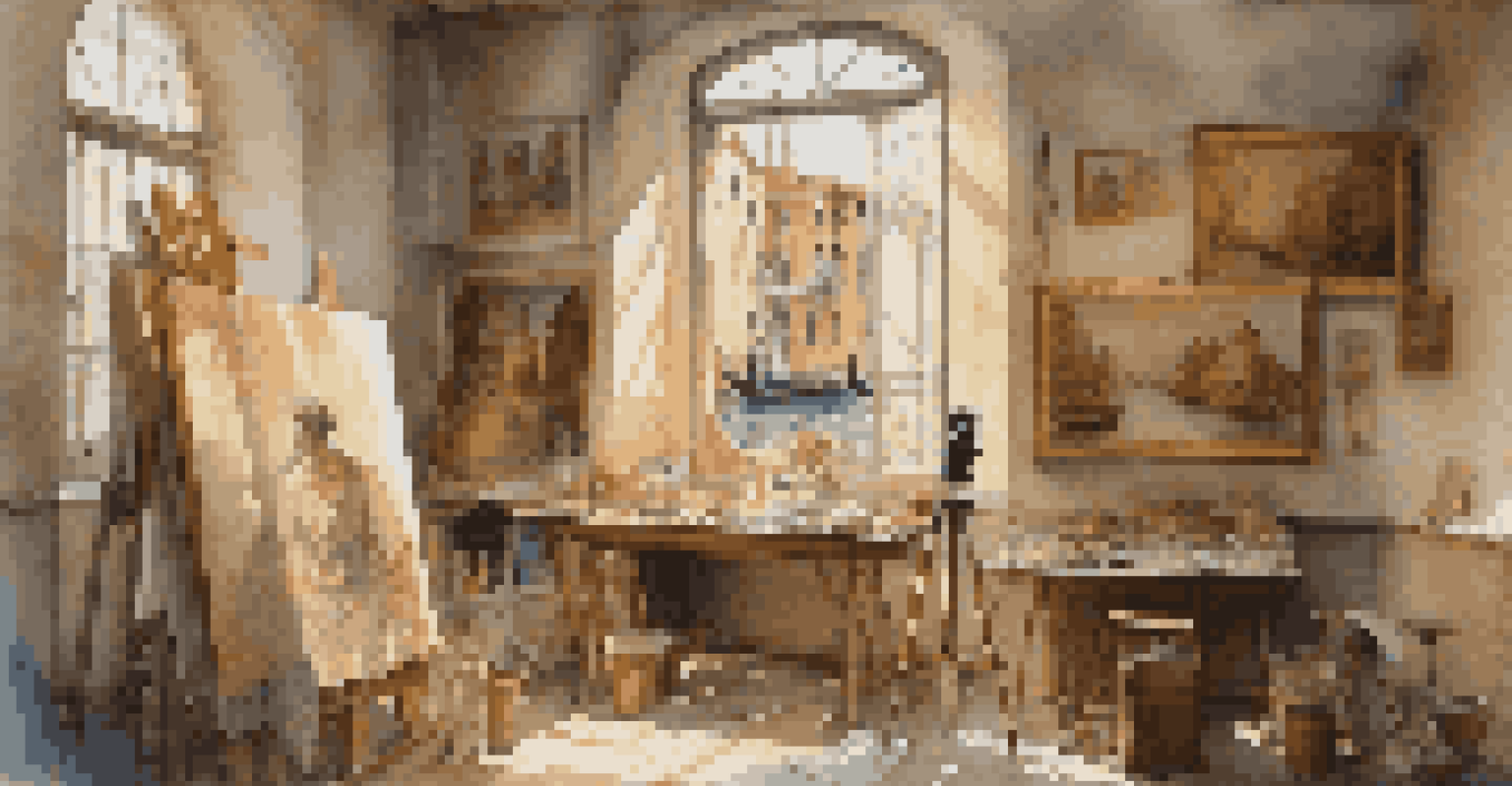The Legacy of the Venetian Renaissance on Art and Architecture

Understanding the Venetian Renaissance: A Brief Overview
The Venetian Renaissance, flourishing between the 15th and 16th centuries, was a vibrant period that transformed art and architecture in Venice. Unlike its counterparts in Florence and Rome, Venice's unique geography and trade connections led to a distinctive cultural expression. This era saw an infusion of influences from the East, creating a rich tapestry of artistic styles and ideas.
Art is the most beautiful of all lies.
Artists like Titian and Tintoretto emerged during this time, pushing boundaries and experimenting with color and composition. Their works reflected not just the beauty of Venice but also the complexity of human emotion, paving the way for future artistic movements. Architecture, too, evolved, with structures like the Basilica di San Marco embodying the grandeur of the period.
Understanding this legacy is essential, as it laid the groundwork for modern art and architecture. The Venetian Renaissance wasn’t merely a local phenomenon; it influenced artistic practices across Europe, making its mark on the global stage.
The Role of Trade in Shaping Venetian Art
Venice's position as a major trading hub significantly influenced its artistic development. The city's wealth allowed for the commissioning of grand artworks and architectural projects, showcasing the power and prestige of its merchants. This economic backdrop created an environment where artists could thrive and innovate, integrating diverse influences into their work.

Trade also facilitated cultural exchanges, bringing in ideas, materials, and techniques from around the Mediterranean and beyond. For example, the use of vibrant pigments from the East transformed how color was utilized in painting. Artists began to experiment, leading to the rich, luminous quality that defines Venetian paintings.
Trade Shaped Venetian Art
Venice's role as a major trading hub fostered economic growth and cultural exchanges that significantly influenced its unique artistic identity.
Thus, trade was not just a catalyst for economic growth but also a crucial factor in defining the artistic identity of the Venetian Renaissance. It contributed to a unique blend of styles that would resonate throughout the ages.
Key Artists: Influencers of the Venetian Renaissance
The Venetian Renaissance was marked by several key artists whose works defined the era. Titian, often regarded as the greatest Venetian painter, revolutionized the use of color and light, creating dynamic compositions. His ability to capture the human spirit in portraits and religious scenes set a new standard for artistic expression.
The painter tries to master color and form, while the artist seeks to express the complexity of emotion.
Another prominent figure, Tintoretto, brought a dramatic flair to his paintings, utilizing movement and emotion to engage viewers. His works often depicted biblical scenes with an intensity that was both captivating and thought-provoking. Together, these artists not only shaped Venetian art but also influenced generations of artists worldwide.
These creative geniuses left behind a legacy that transcends time, illustrating the power of art to convey complex narratives and evoke deep emotions. Their innovative techniques and visionary ideas continue to inspire contemporary artists today.
Architectural Innovations of the Venetian Renaissance
Architecture during the Venetian Renaissance embraced a blend of Gothic, Byzantine, and classical elements, resulting in a unique style that defined the city's skyline. Notable structures, such as the Doge's Palace and the Rialto Bridge, showcased intricate designs and innovative engineering. These buildings not only served practical purposes but also symbolized the wealth and power of the Venetian Republic.
One of the key innovations was the extensive use of marble and decorative elements, which gave buildings a sense of grandeur and elegance. Architects like Andrea Palladio further advanced the field by integrating classical proportions and symmetry into their designs, influencing architecture well beyond Venice.
Key Artists Influenced Generations
Titian and Tintoretto, leading figures of the Venetian Renaissance, revolutionized artistic techniques and left a lasting legacy that inspires modern artists.
The impact of Venetian architecture is still felt today, as many principles established during this period continue to inform modern design. The harmonious blend of function and beauty remains a guiding principle in architectural practice.
The Influence of Religion on Venetian Art and Architecture
Religion played a pivotal role in shaping the art and architecture of the Venetian Renaissance. The Catholic Church was a major patron of the arts, commissioning numerous works that depicted biblical themes, saints, and religious narratives. These artworks were intended to inspire devotion and communicate spiritual ideals to the public.
Venetian churches, such as Santa Maria della Salute, exemplified the intersection of faith and architecture. The grand designs and elaborate frescoes within these spaces reflected the city's deep religious commitment while also showcasing the artistic prowess of its creators. This sacred environment fostered a unique atmosphere where art became an integral part of worship.
As a result, the legacy of religious art from this period continues to resonate, reminding us of the profound connection between spirituality and creativity. The works produced during the Venetian Renaissance invite viewers to explore deeper meanings and celebrate the divine through artistic expression.
The Role of Women in the Venetian Renaissance Art Scene
While the Venetian Renaissance is often dominated by male artists, women played a crucial role in the art scene, albeit in less visible ways. Many women contributed as patrons, providing financial support and resources that allowed male artists to thrive. Additionally, some women, like Sofonisba Anguissola, gained recognition for their artistic talents, challenging societal norms.
Women also engaged in the production of textiles, ceramics, and other decorative arts, which were highly valued in Venetian culture. Their craftsmanship often went unnoticed, yet it formed an essential part of the artistic landscape of the time. This hidden contribution laid the groundwork for future generations of female artists.
Religion's Impact on Art
The Catholic Church's patronage during the Venetian Renaissance played a crucial role in shaping art and architecture, intertwining spirituality with creativity.
Recognizing the role of women in the Venetian Renaissance enriches our understanding of the period and highlights the collaborative nature of artistic production. Their influence, though often overlooked, is a vital part of the legacy that continues to inspire today.
Preservation and Legacy of the Venetian Renaissance Today
The legacy of the Venetian Renaissance is preserved today through the ongoing efforts of museums, galleries, and cultural institutions. Many original works can be found in renowned museums, allowing contemporary audiences to appreciate the brilliance of artists from this period. Restoration projects aim to maintain the integrity of these masterpieces for future generations.
Beyond physical preservation, the influence of Venetian art and architecture continues to inspire modern artists and architects. The principles of color, composition, and design established during this time are still evident in contemporary practices, showcasing the enduring impact of the Venetian Renaissance.

As we explore this rich legacy, it becomes clear that the Venetian Renaissance is not just a chapter in history but a living influence that shapes the cultural landscape. The creativity and innovation of this era remain relevant, reminding us of the power of art to connect us across time and space.